Paintings
Paintings It is somewhat difficult to determine how ancient has been the growth of the art of painting in Bengal. But in terms of authenticity of the finds, the earliest paintings in Bengal were the palm-leaf 'Buddha miniatures' found at Nalanda College dating to the period of King Mohipala Dev (993-1043 AD) during the Pala dynasty (750-1162 AD). In artistic value, the Nalanda finds ranked equal to the most classical 'Ajanta murals' of western India. Consequently, it can be assumed that the Nalanda miniatures were not the most ancient or oldest paintings of Bengal. The tradition of the art was surely known in the region long before that time.
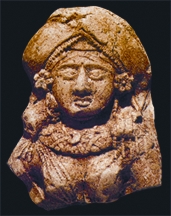
Evidence of the earliest human settlement in the region of Bengal has been found at 'Pandurajar dhibi' (mound of Pandu king) in Burdwan district of West Bengal. Here utensils similar to those used by the settlers at Harappa have been found. The oldest specimens of the skills of the earliest painters were found in the decorative designs painted on potteries discovered at the mound. The ancient potters painted not only abstract and semi-abstract designs but at times also sketches of fishes and birds demonstrating their spontaneity rather than their skill. Of particular significance is the absence of animal or human figures in the painted potteries found at the Pandu king's mound. Those figures are however seen in the contemporary potteries found in the remains of the Indus civilisation.
The history of the pre-Pala eras of Bengal like those of Mauriyas, Sunga and Guptas is hazy. Likewise, the history of art work of those eras is fragmentary and scattered making it difficult to form any clear view of those works. In this context mention may be made of terracotta slabs of Mauriya age (322-185 BC) found at ancient 'Pundranagar' of Mahasthangarh in Bogra in Bangladesh and of similar slabs of the Sunga era (185-71 BC) found at 'Chandraketugarh' of the same area. The terracotta slabs of the post-Gupta period (6th and 7th centuries AD) found at Mainamati and the slabs of the early Pala age (8th and 9th centuries AD) found at Paharpur may also be taken into consideration. The slabs are comparable to the art work as these are executed in 'relief' form providing a kind of natural picturisation.
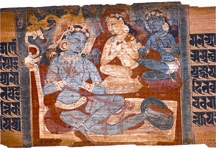
Those terracotta slabs depicted a variety of motifs including flowers, leaves, animals, birds, men, women, gods, goddesses and imaginary tales and ballads. These art works of the local craftsmen may not have been equal to the royal standard but nevertheless boldly depicted the folklife of Bengal. These terracotta slabs permit a peep into the unknown art work of Bengal of the pre-Pala period. It may be noted that traditional Indian art was essentially a product of ‘cooperative’ efforts. Consequently, there existed a close link among the craftsmen doing architectural work, sculpture, painting and other connected works.
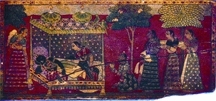
The earliest primary specimens of painting in Bengal are said to be of the Pala period. These miniature Buddhist paintings done on palm leaves of manuscripts and their wooden covers are known in the history of Indian art as 'Pala-painting'. The first thing to note about the Pala paintings is that although these works formed part of the manuscripts they did not illustrate the texts; rather these miniature paintings of the images of Buddha and other Buddhist deities were essentially meant to bless the manuscripts. The Pala paintings in fact heralded the beginning of the era of miniature painting in India. Although very small in size, Pala paintings need not be called real miniatures. For it is a requirement for miniatures to illustrate minutely the subject matter of the book. This important requirement is missing in Pala miniatures. The Pala miniatures show the characteristics of 'murals' or wall paintings. Although the Pala paintings done in gouache medium follow linear pattern they are not decorative. The artist tries to use the lines simultaneously in various thicknesses to create an impression of dullness for the subject matter. At times whiteness is seen to have been added to the paint for purposes of 'modeling'. It is worth mentioning that painting in India developed into its classical stature during the final phase of the Gupta era (320-575 AD). The Ajanta murals of western India are its finest manifestation. Plenty of specimens are found of Pala paintings of the closing years of the tenth century and this continued even after the founding of Muslim rule in Bengal in the twelfth century. Paintings of a different trend started appearing at that time because of changed cultural atmosphere at the courts of the Muslim Sultans. The painting technique of the Sultani courts followed entirely the traditional 'Safavi technique' of the Persians. During the fifteenth-sixteenth centuries, however, some local influence started appearing in Sultani paintings.
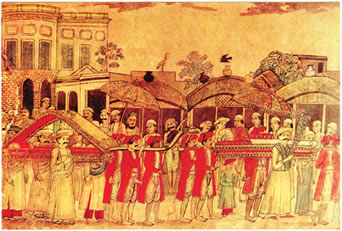
The influence of Sultani paintings of Bengal did not, however, totally overshadow the technique of the local painters. During the rule of Sultan Husain Shah (1494-1538), a new trend of culture developed in Bengal under the influence of Sri Chaitanyadev of Navadweep (1485-1533). Under its impact a new kind of painting of Bengal's grew at Vishnupur and other places during the seventeenth century and the early years of the eighteenth century. One of its products was a paper painting called 'jaranopot' (wrapped-up paper). Another was 'patachitra' or a painting on a wooden plank used as manuscript cover. These paintings done in bright colours depicted tales of devotion to Vaishnavism. It is worth noting that these paintings combined the characteristics of minuteness of miniatures and expansiveness of murals. Many of the traits of Bengal's traditional folk art are however present in these paintings.
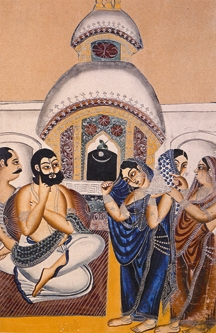
An independent trend of painting called 'Murshidabad technique' having influence of Mughal painting surfaced during the rule of Alibardi Khan (1740-1750) after he established the capital of Bengal at Murshidibad in 1704. It was distinguished for its very orderly and restrained technique with predominance of cool shadowy colours. Besides having the influence of Mughal painting, the Murshidabad paintings also combined the influences of Rajputana painting and the traditional folk art of Bengal.
Keeping the taste of the foreign patrons in view, the local painters of Murshidabad and later of Calcutta painted realistic works on the lives of the people and on nature. These paintings came to be known as 'Company paintings'. This imposed technique lived even after the Company rule ended with the Sepoy Mutiny of 1857.
After establishment of direct rule of the British empire in India, an 'art school' on western style was founded as an institution in support of the colonial economy. The Indian painters had no tradition of institutional training as they learnt the art in hereditary way to preserve its purity. With the introduction of institutional training, a change was inducted in the technique of the art and in the heredity of the artists. This is how the history of art in Bengal or India of the ancient and middle ages ended ushering in modernism. [Faizul Azim]
Prominent among those who, after partition of India in 1947, began practicing the art of painting in the then East Pakistan under the leadership of Shilpacharya zainul abedin were creative painters namely Shafiuddin Ahmed, quamrul hassan and sheikh muhammad sultan. The common thread of unity noticeable among the post-forties painters was their efforts to portray in their art the nature and life of the people of their own land.
Zainul Abedin was the pioneer of painting in Bangladesh in modern time. His series of paintings on the Bengal famine of 1943 brought him India wide fame. These paintings were a spontaneous, sympathetic and bold depiction of a pathetic human tragedy and drew the attention of art lovers abroad. His famine sketches done in mere black lines of the brush using very little pigment and measured space were gradually turned into a technique of his own. In due course, his very well-known works like 'Bidrahi', 'Moi Deya', 'Santal Jugal' and 'Samgram' were done in the same technique. Zainul Abedin also did some paintings applying geometric synthesis to motifs of folk art such as 'Painyar Ma', 'Prosadhan' and 'Guntana'. His scroll painting 'Nabanna' done in the background of the mass movement of 1969 and the scroll painting 'Monpura 70' done in the background of the cyclone of 1970 depicting the utter helplessness of the devastated people are two of his more well-known paintings.
Shafiuddin Ahmed, one of the painters of the forties, was also a pictographist. He earned distinction as a creative artist who believed in achieving excellence in his work. Worth mentioning are his paintings of early phase 'Boner Pathe', 'Santal Bala' and 'Ghorey Phera'. Later, water, fish, boat and symbolic eyes became the primary themes of his painting and pictographic work. Gradually, he turned to applying geometric designs to semi-abstract themes and became keen to use the motifs of folk artists of the country in his paintings.
Qamrul Hassan joined the bratachari movement of Gurusaday Dutta at an early age and this had a durable impact on his whole life. This impact is noticeable in his interest in folk arts, dolls, sculpture and crafts and in their use as a source of inspiration in his own paintings. His early paintings showed female figures as full-bodied as dolls with tall neck and eyes and nose in the shape of folk art. His works of this style are 'Tinkanya' and 'Goontana'. Qamrul Hassan was immensely inspired by the mass movement of 1969 and the liberation war of 1971 and the social and political impact of these events were amply reflected in his paintings. The entire nation was deeply moved by his war-time poster that said: 'Ei Janoyarder hatya korte habe' (These beasts have to be killed). The post-liberation despair and frustration was also reflected in his works symbolically.
Sheikh Muhammad Sultan, a contemporary of Qamrul Hassan, was an exceptional painter. His exception in his art and artistic thoughts was as distinct as was his lifestyle and conduct. The grotesque muscle-rich human figures in his paintings are seen connected with the soil of the land symbolizing invincibility of human person. The ordinary monotony of rural routine of planting seeds, tilling the soil, fishing and harvesting crops is broken in his paintings by the powerful display of hugely magnified defiant human body.
In the fifties quite a few Bangladeshi painters received long-term training in a number of western countries. Through books, copies and exhibitions the contact of our painters and their students with the world paintings became quite close and direct. It was through the work of those painters who after training at the Art Institute of Dhaka appeared on the scene in the fifties that modernism in painting in this country developed. What naturally attracted our painters most was the contemporary popular international trend and appeal of surrealism. The result was the practice of abstract trend of European art techniques.
A senior painter of the fifties, Muhammad Kibria, joined other contemporary painters in Dhaka after completing his education at Calcutta Art School. He established a completely distinct trend in painting and pictograph in Bangladesh by way of presenting his very own trend of colour and abstract form. Another leading painter of the fifties, Aminul Islam, found his own distinctiveness in abstract form but at times his brushes showed human body, broken glass and collage. Aminul Islam also executed some well-known wall paintings using fresco and mosaic techniques. hamidur rahman was an experimentalist painter. Despite his multi-faceted talent, he was primarily an expressionist through realistic as well as abstract techniques. He was a pioneer in mural work in this country. He along with sculptor Novera Ahmed designed the historic shaheed minar that commemorates the martyrs of the language movement. Rashid Choudhury works in oil as well as in less popular tempera, gouache and other mediums. His distinction is however in tapestry. Rashid Choudhury turned to the tradition of folk art of the country in quest of his medium. He tried to blend in his work the peculiarities of folk art's colours, dual dimension, play of light and shade and of the technique. Murtaza Bashir, also of the fifties, was another exceptional painter who loved to make experiments. He worked not only in the fields of painting, murals, pictograph and sculpture but also in the arenas of literature, cinematography and research. His creativity constantly reflected an ever changing and prying psyche. At different times he worked in realistic and abstract techniques. Abdur Razzak worked as a painter, sculptor and also in graphic medium. His journey through various mediums gradually led him to abstract expressionism.
Qayyum Choudhury was one of those painters whose traditional thoughts centred round folk arts. The craftsmanship and motifs of folk arts inspired him. Qayyum Choudhury's most recent paintings demonstrate an exuberance of undiluted colours and most obvious suggestion of folk motifs and designs. His works also show that their execution has become more spontaneous and bold. The experimental first phase works of Devdas Chakravarty show in semi-real style such subjects as human figures, processions and female faces. In the second phase, he follows his contemporaries in moving away from realism to abstract expressionism. Syed Jahangir, like others of his school of thought, too became attracted to abstract expressionism. At the initial stage of abstract work, his canvases were replete with pebbles and elongated four-cornered shapes, symbolizing life's ceaseless flow. His later works became far more philosophical. The first-phase works of Kazi Abdul Baset showed various aspects of rural life, especially a solitary woman or women in pairs. After returning from abroad, Abdul Baset also began painting in abstract form. He gradually moved away from apparent visibility of shapes in nature to a more symbolic view.
Among those who, alongside the more well-known painters of the fifties, were dedicated to creative work were nitun kundu, Kazi Abdur Rauf, Syed Shafiqul Husain, Shahtab, Mubinul Azim and Shamsul Islam Nizami. Nitun Kundu demonstrated skill in oil, pictograph and sculpture.
One of most notable painters of sixties decade is Abu Taher, a feature of his abstract painting was creation of a rough ravaged surface to accentuate sensitivity. Samarjit Roychoudhury adopted for his painting many elements and motifs of Bangladesh's nature and folk life. Hashem Khan became more well-known for his commercial art, especially in book publishing, cover illustration and also in ornamentation. But he was also one of the more prominent painters of the sixties. He was a politically and socially conscious person and was therefore keen to present in his works symbolism, meaning and message. Although more well-known as a book cover designer and cartoonist, Rafiqun Nabi is now a leading pictographist of the country, especially after his overseas training. He arranges his subjects somewhat in folk and somewhat in geometric styles. Some more painters of the sixties have been painting in abstract or semi-abstract forms. Prominent among them are Delwar Husain, Golam Sarwar, Muhammad Mohsin and Anwarul Huq Piyaru.
In seventies decade the contribution of painter Qamrul Hassan deserves special mention. The poster painted by him with the slogan 'These beasts have to be killed' greatly inspired the freedom fighters. Independent Bangladesh witnessed the onrush of a new awakening in the field of art as in all other fields. At that time new art institutes were established at Chittagong, Rajshahi, Khulna, Narayanganj, Bogra and other places to permit wider training and culture of artistic activities. Among the celebrated painters of the seventies was Monirul Islam who lives in Spain. Among the Bangladeshi painters he perhaps earned the greatest international fame and recognition. In the area of pictography his skill put him among the front-ranking artists. Very recently his painting has turned into a combination of very delicate lines, spontaneous touch of colour, sporadic splash of brush and drops of blood creating a pleasant impression of pure delight.
Another reputed painter of this decade is Shahid Kabir. His artistic thoughts have somewhat been influenced by mystic spiritualism, crisis of human existence and haunting of death. His recent paintings, however, show him making a different effort by way of splashing colour with abandon on trifling things occupying broad spaces of the canvas. Monsurul Karim is experimental in attitude in his painting. Very recently his bold expression of maturity and a style of his own has particularly attracted the attention of art lovers. Chandrashekhar De skillfully uses the mutuality of delicate abstract form with sympathetic colour. But he has lately been working on simplified human figures and at times on very decorative designs.
Hashi Chakravarty's primary attraction is towards delicate balance of colour and play of light and shade as in nature. His colour balance and dancing of light and shade create in his work a world of rhythmic fantasy.
Qazi Gias is a permanent resident in Japan. In both water colour and oil he prepares his ground in dense weaving pattern. In using colour he demonstrates skill in delicate balance. Swapan Choudhury is keen to create a sensitive background fixing a variety of objects on the canvas. Kalidas Karmakar was a sensational artist of the seventies. He distinguished himself in using a variety of mediums and uniqueness in presentation. He used oil, gouache and a variety of mixed colours. Whether using realistic or abstract forms he was always oriental in his work. Mahmudul Huq received higher training in Japan. Although he developed skill in pictograph, he remained essentially focused on oil and constantly moved towards removing from the background separate spaces of geometry and pigment and fusing them into an abstract form where pigments dissolve into each other leaving a shadowy atmosphere. Shahabuddin Ahmed is a permanent resident in Paris. The liberation war kept him fully absorbed and the experience of that war taught him that the human body contains a tremendous amount of force and speed. He let the wild movement of his brushes break the mere reality of the human physique and create a different sensuousness. KMA Qayyum is a contemporary of Shahabuddin. His paintings are a pure unmixed beauty. Qaiyyum is a born romantic and although his paintings do not exhibit any apparent figures they do transmit a sense of organic liveliness. Farida Zaman has chosen as her subject such ever familiar objects of Bengali life as river, fish and fishing net. Although much used by others before her she has been able to bestow these objects an entirely new character. Others notable painters of the seventies are: Manzurul Hye, Biren Shome, late Mahbubul Amin, Abul Barak Alvi, late kazi hasan habib, Asem Ansari, Maruf Ahmed and Banizul Huq.
The trend of painting in the eighties saw experiments with a variety of mediums in different branches of art. A special trend of the decade was the arrival of a large number of women painters. In giving due place to the traditions and heredity in the art in the decade, intellectual attitude took the place of sentiment. The ultra-modern tools of the western world occupied more space in Bangladeshi art. Abstract form remained a major trend but other ultra-modern trends of the west such as conceptual art, especially installation, began to make inroads into the art in Bangladesh.
Many painters of the eighties developed their own language of the art. Others were engaged in experimenting or at the formation stage. Despite all this a few of the painters have attracted attention of the art world by virtue of their creativity and powerful expression. They have earned for themselves a place of importance in Bangladesh art. Some of them are Ranjit Das, Kazi Raqib, Jamal Ahmed, Muhammad Yunus, Tarun Ghosh, Shahadat Husain, Ruhul Amin Kajol, GS Kabir, Dhali Al-Mamun, Nasreen Begum, Rokeya Sultana, Shishir Bhattacharya, Nisar Husain, Najli Laila Mansur, Dilara Begum Jolly, Sheikh Afzal, Nilufar Chaman and Atiya Islam Annie.
It was from the nineties that new thinking started having widespread influence in Bangladeshi art. Artists have, in addition to installation or building work, begun to do videography, performance, site-specific art, happening etc. These techniques of the art can no longer be judged in the confines of the traditional departments. Many of the new generation artists of the nineties have been practicing international techniques and have already shown considerable promise.
Those who have been working since the inception of the nineties mainly in painting and painting-related mixed techniques include Abdus Shakur Shah, Kanakchanpa Chakma, Mahbubur Rahman, Toiyeba Begum Lipi, Ashok Karmakar, Sulekha Choudhury, Tasadduk Husain Dulu and Roni Ahmed. Among those who are now coming up working mainly in the painting- related fields are Fahmida Akhtar Kakoli, Faruk Ahmed, Bipul Shah, Zahed Ali Choudhury, Ashraful Hasan, Abdus Salam and many others. [Abul Mansur]
